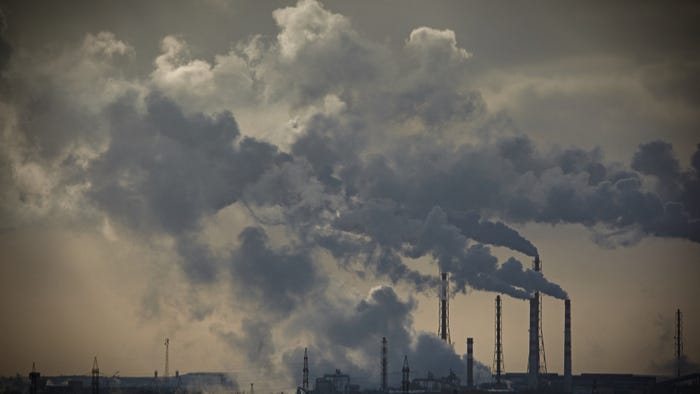The Donora Smog, Part II (1948)
Humans vs. the environment vs. themselves.
This is Throwbacks, a newsletter by me, Michael Weinreb, about sports, history, culture and politics, and everything in-between.
If you like what you read, please click the button below, join the mailing list for FREE and please share, on social media or through e-mail or however you feel comfortable sharing.
And if you’ve been reading for a while, please consider a paid subscription to help keep this thing going—you’ll also get full access to the historical archive of over 200 articles. (Click here and you’ll get 20 percent off either a monthly or annual subscription for the first year. And if your subscription is up for renewal, just shoot me an email and I’ll figure out a way to get you that discount, as well.)
Author’s Note: I wrote the first two passages of this newsletter four years ago, amid a post-apocalyptic environmental event in northern California that led to one of the most surreal Monday Night Football games in modern history.
The original post is below. It seems worth revisiting today, with a new addendum in Section III.
I.
It was late October of 1948 in Donora, Pennsylvania, and a football game loomed on the horizon, even if the air was so thick you could hardly see what lay ahead of you. This was a rivalry game with nearby Monongahela—two of those suburban steel towns near Pittsburgh who had helped turn high-school football into a cultural touchstone in western Pennsylvania—and nothing was going to stop it, not even the bizarre and inexplicable fog that had rolled into town, turning the air a distinct shade of yellow, and draping the entire town in an odd shroud of stillness.
On Friday night, as much of the town turned out for a Halloween parade, the Donora Dragons practiced kickoffs amid the haze, their coach yelling “Kick” each time so that the receiving team knew when the ball was headed their way. “The sturdy people of Donora were not perturbed,” writes Devra Davis in her book When Smoke Ran Like Water. “Donora did not abandon its routines easily.”
On Saturday, the Monongahela game went off as planned, with full pep rallies and marching bands, even though most of the fans couldn’t see enough to know what was actually happening. And at that point, they didn’t know, which was why when the call came over the loudspeaker for star tight end Stanley Sawa to “Go home! Go home now,” some people presumed it was a prank.
Sawa raced home in his uniform, wending his way through Donora’s steep streets, still carrying his helmet in his hands. There, he saw a neighbor in the living room, who pointed to the bedroom, where his father—who worked at the nearby mill, lugging iron ore—lay next to a doctor. Sawa’s father had come home from work, lay down, and never woke up. By the time Stanley Sawa arrived, his father was already dead. And over the course of the next several days, nineteen more people from Donora and nearby Webster—including the father of future baseball Hall of Famer Stan Musial—had died, as well, the victims of a toxic cloud of smog from a nearby zinc plant that was, up to that point, the worst air pollution disaster in American history. Seven thousand others suffered health effects. If rain hadn’t swept through Donora on Sunday, experts say, the death toll could have been in the thousands.
II.
“(Donora) jumpstarted the fields of environmental and public health, drew attention to the need for industrial regulation, and launched a national conversation about the effects of pollution,” wrote Lorraine Boissoneault in Smithsonian. In fact, two years after Donora, Harry Truman convened the first national air pollution conference, and fifteen years after Donora, Congress passed the first clean-air act. (U.S. Steel, which owned the factories responsible for the pollution, wound up settling lawsuits filed by residents, but never accepted blame, attributing the cloud of smog to “an act of god.”)
“But in doing so,” Boissoneault wrote, “(Donora) pitted industry against the health of humans and their environment. That battle has continued throughout the 20th century and into the 21st, with short-term economic interests often trumping long-term consequences.”
III.
I moved to California for the first time when I was 22 years old. I drove a hand-me-down Toyota Camry three thousand miles through cornfields and deserts and settled into a sublet off Sepulveda Boulevard, where I began a three-month internship at the San Fernando Valley edition of The Los Angeles Times, back in the days when major newspapers were such a lucrative enterprise that they would divide their print editions into geographic zones in order to serve them better. All around me, as I drove to cover high-school basketball games and volleyball matches, the scars of the Northridge earthquake were still visible across the landscape. When I tried to make my way over the canyon roads and into Malibu, they were periodically closed due to prolific flooding.
Everyone has this revelation when they move to California--that moment when they
Keep reading with a 7-day free trial
Subscribe to Throwbacks: A Newsletter About Sports History and Culture to keep reading this post and get 7 days of free access to the full post archives.



